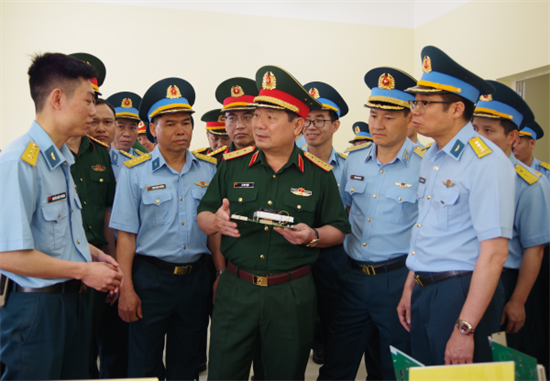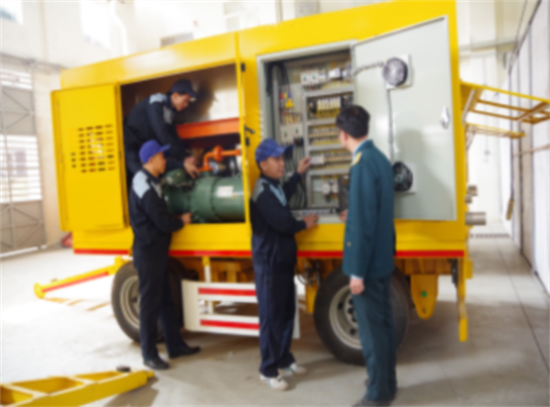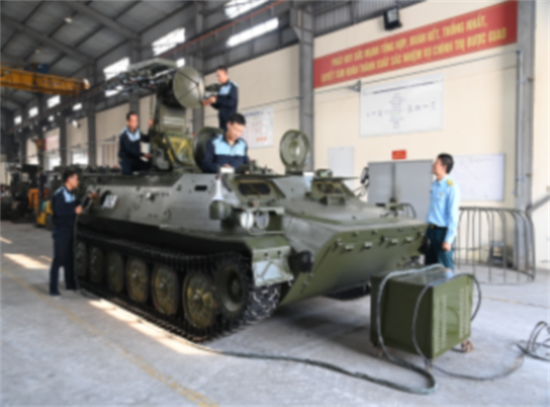“Three breakthroughs” to enhance weapon and technical equipment repair capability at Factory A34
Factory A34 is one of the top technical support facilities of the Air Defence - Air Force Service, tasked with carrying out medium and major repairs of anti-aircraft guns, short-range missiles, and specialised vehicles and machinery, manufacturing optical equipment, measuring instruments, oxygen, nitrogen, materials, and spare parts, and applying scientific - technological advances to repair, upgrade, and modernise weapons and technical equipment for units of the Service and the Air Defence Force across the entire Military.
 |
| Sr. Lt. Gen. Le Huy Vinh, Deputy Minister of National Defence inspects the Factory’s repair capability in 2025 |
In recent years, the rapid development of science and technology and the drive to modernise the Service have placed ever-greater requirements on the Factory. Weapons and equipment sent to the Factory have been in use for many years, with various types of damage requiring medium and major repairs. Meanwhile, replacement materials and spare parts have been increasingly scarce; many specialised components are no longer manufactured, thereby leading to dependence on expensive foreign supplies; the Factory’s facilities and equipment have been limited; technical staff members of the Factory are working at 2 sites, with varying levels of knowledge and skills, and they are frequently deployed to provide technical support for units across the Service.
Against that backdrop, the Factory’s Party Committee and Board of Directors (BOD) have actively renewed their leadership and direction thinking and made “three breakthroughs” to improve overall capacity, gradually master core technology, and apply digitalisation, modelling, and automation solutions to raising the quality and effectiveness of repair and manufacture.
1. Building “technological human resources”
As weapons and technical equipment of the air defence force become increasingly modern, diverse in type, and technologically sophisticated, repairing and upgrading them, first and foremost, requires the development of “technological human resources”. Hence, the Factory has focused on building a corps of technical cadres and employees as “technology-oriented workforce”, with highly, specialised skills and expertise, capable of mastering equipment, undertaking research, fostering innovation, and quickly adapting to the trend of digital transformation in military technology. It has stepped up the reorganisation of its manpower in an “adept, compact, effective” manner, proactively reviewing, designing, and executing strategies to recruit, train, and develop high-calibre human resources with political steadfastness and standardised qualifications according to each position. To that end, while recruiting high-quality human resources from academies, schools, and units, it has diversified forms of personnel training and development and combined on-the-spot and technology transfer training with the deployment of its staff members to training centres both inside and outside the Military. Great value has been attached to building a pool of highly skilled young engineers and technicians with proper age ranges as the core force in different specialities.
 |
| ĐH41-4000-M1 air conditioning trailers manufactured by the Factory |
To improve its staff’s capabilities in mastering equipment and effectively, safely operating technological lines, the Factory has regularly organised refresher courses for technical cadres and employees. Between 2020 and 2025, it has coordinated and held tens of refresher courses on improving skills and using new equipment and technological lines for hundreds of technical cadres and employees. Those refresher courses have been closely linked to specific specialities and task execution, with the participation of top experts both inside and outside the Service. Besides, the Factory has attached importance to promoting the role of highly skilled technical cadres and employees, who took part in major projects on upgradation, modernisation, and complex overhauls, in sharing their experiences and training younger engineers and workers. At the same time, it has encouraged its staff members to enhance self-study to improve their capacity and skills, master new technologies, and meet their task requirements. To enable its personnel to meet the requirements of researching and manufacturing specialised technical materials, the Factory has established product research and development teams tasked with undertaking research topics and innovations, designing and piloting material samples, modelling replacement equipment, and researching new repair technologies.
Thanks to its drastic, synchronised solutions, the Factory has succeeded in building a contingent of key technical cadres with great professional expertise, hands-on experience, and capacity to master new technology and modern equipment. Since the beginning of 2025, those key cadres have proposed and implemented a lot of effective models; noticeably, their initiative of installing night cameras and laser rangefinders within the electro-optical system of the semi-automatic night-time 37mm-2N anti-aircraft gun company has been technically accepted and put into practice, greatly contributing to raising the Air Defence Force’s combat readiness capacity and combat strength and building a modern Service.
2. Investing in modernisation of technologies and equipment
In response to the increasingly high requirements of technical support set by the rapid development of military science and technology, the Factory’s Party Committee and BOD have prioritised investment in modernisation of key technological lines, encouraged science research, and focused on manufacturing and mastering technological products. This measure is aimed at laying a solid technical foundation for improving the capability to repair weapons and technical equipment and meeting the task requirements in the long term and short term. To that end, the Factory has focused its resources on modernising key technological lines in accordance with the specialised task of repairing new-generation air defence - air force equipment. It has implemented many projects to upgrade its facilities and modernise its equipment, means, and technologies. Notably, it has consolidated the repair line for anti-aircraft artillery and short-range missiles (including facilities, repair equipment, and test stands) at 3CY-23 and Anti-aircraft Artillery - Optics Workshop, investing in hi-tech precision machining systems, specialised electronic equipment for repairing control circuits and electronic modules, as well as automated testing systems.
 |
| Repairing A89 short-range anti-aircraft missile system at ZSU-23 Workshop |
As for science research and technical initiatives, the Factory has effectively executed the emulation movement of “good labour, creative labour”, encouraging its cadres, engineers, and technicians to propose technical initiatives to improve its productivity. Besides, it has remained proactive in manufacturing and mastering new technology products to enhance self-reliance, reduce dependence on imported materials, shorten repair procedures, and increase the reliability of weapons and equipment after repair. In 2024, it manufactured 5 pieces of equipment for repairing specialised vehicles and machinery, 1 set of general testing equipment for semi-automatic night-time 37mm-2N anti-aircraft gun company, 833 technical products for anti-aircraft guns and short-range missiles, and 4 ĐH41-4000-M1 air conditioning trailers. Since the beginning of 2025, it has manufactured 400 categories of technical materials with 546 products for the repair of anti-aircraft guns and short-range missiles and 40 types of technical materials for specialised vehicles and machinery. Those significant achievements have allowed the Factory to gradually deal with the scarcity of spare parts and replacement materials, save production costs, increase proactivity in task execution, and work towards complete self-reliance in providing technical support for hi-tech or specialised weapons and equipment.
3. Developing and managing technological documentation
In order to standardise its production lines, raise the quality of repair, and lay a solid foundation for digitalisation and the development of a “smart factory” model in the foreseeable future, the Factory has attached significance to developing and managing technological documentation. Grasping the Central Military Commission’s Resolution 1656-NQ/QUTW, dated 20 December 2022, on leading technical work towards 2030 and beyond and regulations on technical work, it has both designed and perfected a system of technological documentation relevant to each production line and each group of weapons and technical equipment, ensuring accuracy, inheritance, and high applicability. Since 2020, it has compiled 103 sets of documentation on technological process with 4,929 pages, designing 76 sets of technological manuals with 8,641 pages, forming over 239,927 repair, inspection, and testing sheets which have been widely applied across its production lines, effectively serving production work, facilitating regular and irregular repair of weapons and technical equipment.
While completing documentation for traditional types of weapons and technical equipment, the Factory has attached special importance to designing sets of technical documentation and technological standards for repairing and accepting products, particularly new, hi-tech weapons and military hardware. Moreover, the Factory’s Party Committee and BOD have drastically directed the application of digital and simulation technologies in developing, managing, and exploiting technical documentation. Up to now, 100% of the technical documentation related to the types of weapons and technical equipment undergoing regular repair have been digitalised and stored on the internal network, thereby allowing rapid search and accurate retrieval, forming a common database across the Factory, facilitating repair, production, and technical training, improving the operating efficiency.
Those above-mentioned achievements have proved the soundness and effectiveness of the “three breakthroughs” implemented by Factory A34. That has also showcased the Factory’s proactivity in grasping the technology development trend under the Politburo’s Resolution 57-NQ/TW and the Central Military Commission’s Resolution 3488-NQ/QUTW on breakthroughs in science - technology development, innovation, and digital transformation, laying a solid foundation for the Factory to keep improving its capacity to repair and upgrade weapons and technical equipment, meeting the requirements of modernising the Air Defence - Air Force Service in the new situation.
Sr. Col. NGUYEN XUAN TRUONG
Director of the Factory